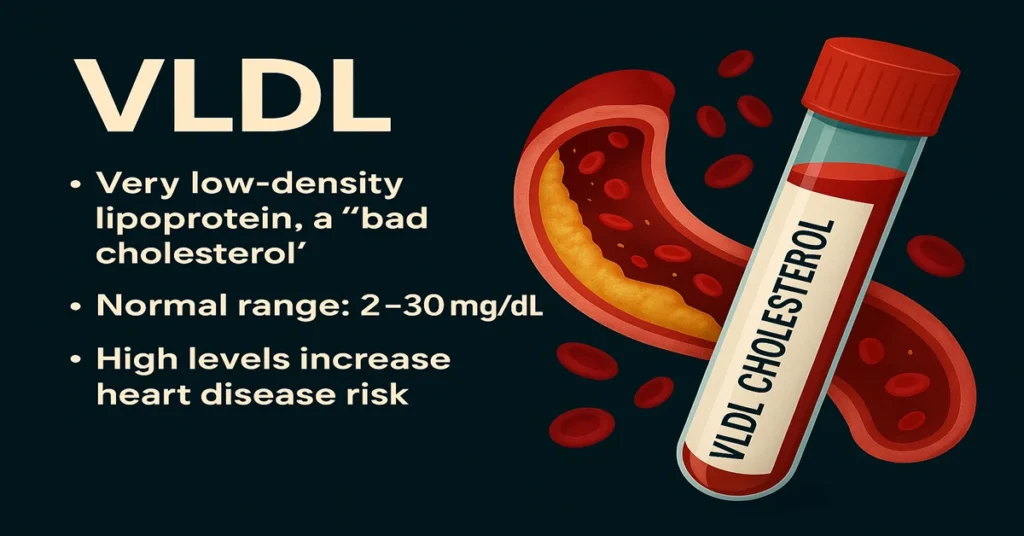What is VLDL (Very Low-Density Lipoprotein)?
VLDL stands for Very Low-Density Lipoprotein, a type of cholesterol particle in the blood.
It is considered a form of “bad cholesterol” because, like LDL, it contributes to the buildup of fatty deposits (plaques) inside arteries. Over time, this condition — known as atherosclerosis — increases the risk of heart disease, stroke, and other cardiovascular problems.
VLDL carries triglycerides, which are fats made from excess calories, sugar, and alcohol. High VLDL levels usually indicate high triglycerides and are a warning sign for heart-related complications.
Where is VLDL Synthesized in the Body?
- Produced in the liver – The liver creates VLDL particles, which are then released into the bloodstream.
- One of the five major lipoproteins: VLDL, LDL, HDL, IDL, and chylomicrons.
- Conversion pathway: VLDL → IDL (Intermediate-Density Lipoprotein) → LDL (Low-Density Lipoprotein).
This process shows how VLDL is part of the body’s lipid transport system, carrying triglycerides first and later converting into LDL cholesterol.
Main Functions and Importance of VLDL
Even though it is harmful in excess, VLDL has some important physiological roles:
- Transports triglycerides from the liver to fat tissues and muscles for energy use or storage.
- Acts as a triglyceride carrier — when energy is needed, stored triglycerides can be broken down.
- Plays a role in lipid metabolism, connecting dietary fat storage and energy usage.
- Eventually converts to LDL, another cholesterol form needed for cell function but harmful in excess.
Causes of Low VLDL Levels
Low VLDL is not common and usually not harmful unless caused by disease or genetic conditions.
Possible causes:
- Malnutrition or low-fat diet
- Chronic liver disease (impaired VLDL production)
- Hyperthyroidism (overactive thyroid)
- Rare genetic disorders like abetalipoproteinemia
- Medications (e.g., statins, fibrates) that lower lipid levels
Symptoms of Low VLDL
Usually, low VLDL does not cause symptoms.
In rare cases (mostly genetic disorders), symptoms may include:
- Poor absorption of fats
- Deficiency of fat-soluble vitamins (A, D, E, K)
- Muscle weakness
- Neurological problems (rare)
Causes of High VLDL Levels
High VLDL levels are more common and often linked to metabolic or lifestyle-related problems.
Common causes:
- Uncontrolled diabetes mellitus
- Obesity and sedentary lifestyle
- High intake of sugar, refined carbs, or alcohol
- Hypothyroidism (underactive thyroid)
- Kidney disease
- Metabolic syndrome (high blood sugar, obesity, high blood pressure combined)
- Genetic lipid disorders
Symptoms of High VLDL
High VLDL levels usually do not cause direct symptoms. But over time, they can lead to:
- Atherosclerosis (artery blockage)
- Heart attack (myocardial infarction)
- Stroke
- Fatty liver disease
- Pancreatitis (in very high triglycerides)
Reference Ranges (Normal Values)
VLDL is usually calculated from triglyceride levels, not measured directly.
| VLDL Level | Interpretation |
|---|---|
| 2 – 30 mg/dL | Normal |
| > 30 mg/dL | High – Increased risk of heart disease |
If your VLDL is high, it often means your triglyceride level is high too.
Sample Type
Sample Type: Serum
Tube Used: Red Top (Plain Tube)
Fasting Required: Yes, usually 9–12 hours
Test Preparation
To prepare for a VLDL test:
- Fast for 9–12 hours before the test (only water allowed).
- Avoid alcohol for at least 24 hours before.
- Avoid high-fat or high-sugar meals before the test.
- Inform your doctor about any cholesterol-lowering medicines.
When to Consult a Doctor
You should seek medical advice if:
- Your VLDL level is >30 mg/dL
- You have other abnormal lipid values (high LDL, low HDL, high triglycerides)
- You are at risk for heart disease, diabetes, obesity, or hypertension
- You develop symptoms like chest pain, shortness of breath, or stroke-like signs
Important Word Explanations
| Term | Meaning |
|---|---|
| Lipoprotein | A particle made of fat and protein that transports cholesterol and triglycerides in the blood. |
| Triglycerides | A type of fat made from excess calories; stored for energy. |
| Atherosclerosis | Hardening/narrowing of arteries due to fat deposits. |
| IDL | Intermediate-Density Lipoprotein, formed from VLDL. |
| Metabolic Syndrome | A cluster of conditions (obesity, high BP, high sugar, abnormal cholesterol) increasing heart risk. |
~END~

